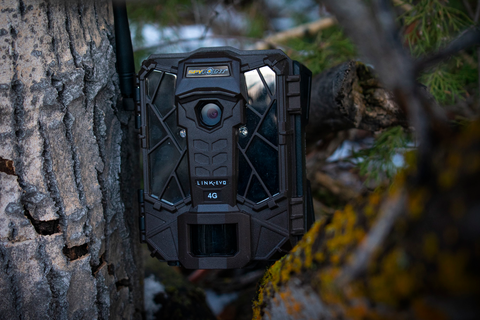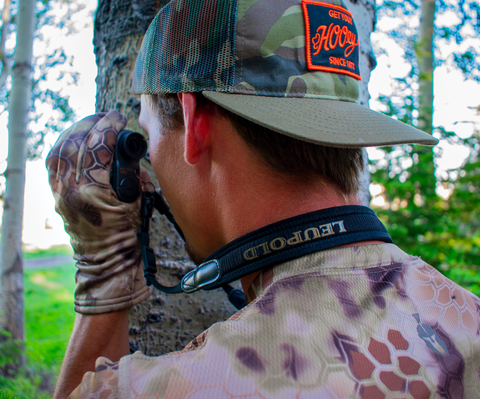Huntsmen Blog
Game Calls for the Novice Hunter
It turns out that if you want to be a successful game or bird hunter, you must learn
to master a game call. Piece of cake you say! I am astonished at the vast array of
big game, predator and bird calls that are available on the market today. I think
there are enough to make even the most experienced hunter scratch his or her
chin, imagine the confusion it causes the novice. So, how does a hunter begin to
navigate this system of game calls? Logic dictates that the first thing a hunter
needs to do is decide on their goals, what they are looking for from a game call.
Once expectations are decided upon, it’s time to look at calls.

Just what are all the call types you ask? There are mouth calls, friction calls and
electronic calls. The cost of these calls can be as low as $10 and as high as a
several hundred dollars. Price range is a definite consideration, but convenience
and ease of use are also considerations that need to be looked at. After all, what is
the sense of spending good hard earned money on a product that you have
difficulty using, or aren’t satisfied with the quality of the sounds you’re emitting?
Consider choosing a reputable brand and be careful of knock-offs. The adage “you
get what you pay for” is certainly true in the world of game calls. Today we are
going to look at the different mouth calls that are available. We will consider friction
calls and electronic options in future discussions.
Mouth calls include any devise in which the air you breathe is used to create the
desired sound to attract the attention of a specific game species. Mouth calls first
originated with the Native Americans who would blow on pieces of stretched grass
to replicate animal sounds. This concept was adopted by game hunters and mouth
calls were created.

One type of mouth call is the diaphragm call as it is referred to. Diaphragm calls
are used for big game, predator and turkey hunting; they are not used for duck
hunting. This call is basically a u-shaped frame of plastic tape that has a latex reed
stretched across the frame. It fits in the roof of your mouth and is activated as you
blow air. These calls can contain several layers of latex reeds, and these reeds
can have various cuts in them, or no cuts. The number of reeds and the various
cuts all contribute to the creation of various tones and animal sounds. Emitted
sounds are also dependent on the force of air being expelled, placement of the
call in the mouth, tongue and lip movement as well as hand movements around
the mouth. Diaphragm calls with a single reed (one piece of stretched latex) and
no cuts is the easiest for the novice caller to experience because it requires less
air. The sounds which are emitted are basic and the call doesn’t allow for a wide
range of pitches and sounds. It does however, give the novice a sense of
accomplishment as they begin the diaphragm call journey. There are other things
to consider when using this mouth call. You need to gauge the size of your mouth.
Some calls are bigger then others, and you want to get one that is not too large,
nor too small for your mouth. If you do get one that is too large, there is a way to
cut them down, but since the call fits in the roof of your mouth, keep this
requirement in mind. Getting used to blowing air while having a foreign object in
your mouth and dealing with some vibration can be interesting, but as they say,
practice makes perfect, so practice, practice, practice.

The hand-held reed calls are another call option. These calls are used in big
game, predator, turkey and duck hunting. Hand-held calls also have reeds
contained within the body of the call which emit various sounds when air is blown
across them. The body of these calls is generally made out of wood,
polycarbonate or acrylic, and come in many different shapes and sizes. They can
contain one reed or two, and the reeds can be open or closed (enclosed). Of
course the easiest hand-held call for a novice to use in duck hunting is a closed
double reed. It seems these are the easiest to learn on, are more forgiving,
provide fairly accurate vocalizations and are reliable for the experienced caller as
well as the novice. The open reed calls take a little more practice and finesse to
master, but provide a broader range of volume, tones and sounds. The majority of
elk calls tend to be open reed calls in order to be able to emit the higher pitched
sounds required in imitating calf and cow sounds.
Whichever call you decide to give a try, don’t be surprised if you are not able to
immediately create the desired sounds with the first blow. As stated earlier,
becoming proficient at game calls takes practice. Repetition, focusing on the
fundamentals and getting to know your call are key elements in mastering game
calls. Last of all, START EARLY! Don’t wait until the week before your hunt starts
to order a game call. Give yourself time to practice with your new call and to watch
some videos on the tips and tricks to mastering your call, so that when your hunt
begins you will be ready and prepared to fill your tag!
Why Choose Badlands Hunting Gear
Using Attractants
In an effort to get a leg up in the hunting world, using attractants to lure in large game such as deer and elk, has become popular, especially when combined with the use of a trail camera. There are lots of different natural and packaged attracts available and it’s important to decide what you want to use and why?
The main purpose for using attractants and trail cameras prior to the start of hunting season is to find out what kind and how many animals are in your prospective hunting area. It seems more logical to put up a tree stand in an area where you have absolute proof it has been frequented by the species you have a tag for. Otherwise, you might be sitting in an area void of the animal type you are looking for!

So, you found an area that shows signs of deer or elk and you want to put up a trail camera. What next? You have a couple options. You can use the natural foods that are around the area and let nature bring the animals in. Check out the vegetation in the surrounding area, see what the game you are looking for would be eating naturally and set up your camera with a view of that area. Some of the vegetation deer and elk will seek after include clover, flowering plants and grasses, berries, and acorns. Animals also require water, so if there is a water source nearby, consider setting up your camera in that vicinity with a good view of the watering hole. You might also look for game trails, keeping an eye out for those which cross streams. These are some options if you are just wanting to see what is normally in the area and follow the natural travel patterns of the animals.



Trail Cameras
Trail cams were a great invention for the avid hunter. One of my favorite parts of the entire hunting experience is scouting! The challenge of finding the animal you’re hunting, watching, learning their travel pattern, what they are feeding on, how many there are, how big and are there any predators following them? So much knowledge can be gleaned from observation. I have a favorite tree stand in the woods, off the beaten path, where I like to go and spend a little time getting to know just what is in my neighborhood. Usually I see deer and elk, single animals, or small herds. Occasionally a momma and her young. One day a pair of young mountain lions with their mom strolled through and parked for a few minutes right under me. That got my adrenaline running just a little. The other thing I do when scouting is set out some trail cameras.

When hunting, you gotta put in the work if you want to harvest the trophy animal. Animals move around depending on the season, food availability and safety. Setting up a trail camera or two helps me to know exactly what is roaming through the hunting boundaries that I am considering. The intel provided by my trail cam pictures can help me put into play an effective harvesting plan. I know that I have to factor in the possibility of change. It seems like animals have an innate sense that tells them the exact day that a hunt starts, and what was there yesterday may be long gone on the first day of the hunt, but at least with trail camera pictures, I not flying in totally blind! One nice feature in some of the new cameras is the ability to receive pictures directly to your smart phone. You know what is circling around your camera without having to wait a week, hike up and retrieve your SD card, go back home and plug it into your computer only to find out the area is a dud! Being able to see in real time what is coming within range of your camera is great, and if you aren’t receiving very many pictures, instead of hiking up to retrieve an SD card, you might know that it’s time to just move the whole setup.
When putting up a trail camera, a few good tips to remember include 1) pointing your trail camera due north whenever possible to avoid poor exposure, backlighting, the sun tripping your camera or possible sun glare; 2) angle your camera at about 45 degrees down the game trail to get a wider field of view to see the animals coming and going; 3) before placing your camera, be sure to wipe it down with a scent eliminator to remove all smells; and 4) depending on the species, attractants can be a useful tool. We have found in our area that berry scented attractants work great for elk and apple scents work best on mule deer.

When setting out trail cameras, there are some common sense etiquette rules that should be followed. First, respect private property. Don’t set your camera up on someone’s private property, especially if it is clearly marked. If you see someone out putting up a camera, don’t follow them. And if you come across someone else’s camera, again, be respectful. Don’t sabotage their efforts. Out of courtesy, don’t ask where someone set up their cameras. Find your own spots. If they want you to know, they will volunteer the information. It’s a good idea to set your camera up somewhere off the beaten path. You might have to do a little hiking, but it will lessen the likelihood of your equipment being vandalized or stolen. Lastly, when you put out a camera, be sure to secure it. Unfortunately in these times, stuff does go missing. If someone wants your camera bad enough they will take it, but make it as hard for them as you can!
Whether you are hunting for that trophy buck, or to put meat in the freezer, your hunting experience should be enjoyable, and success always make the experience that much better. Proper planning, preparation and a trail camera can all help to increase your chances of being successful during your hunt. We at Huntsmen Outdoors wish you a successful, enjoyable hunting experience!
Gloves
Protecting your hands during a hunt is a must! There are many tasks that need to be completed, from loading your weapon to gutting your kill. A good pair of hunting gloves needs to provide you with the warmth your hands require as well as protection from the elements and environment, and still allow you the dexterity you need to complete certain tasks. I’m sure there are probably some of you out there who, like me, might have received some nerve damage to your hands (chemical burns) and the protection of a good glove is imperative! There are several types of gloves available which are constructed of various materials and cater to different needs: warmth, movement, comfort, style. Which glove is right for you?

The full glove is one that covers your entire hand and fingers. This glove provides protection against the environment and elements while still allowing you to preform routine tasks. Some full gloves have a special feature on the finger tips that allow for using your touch screen phone without having to remove your glove. Some full gloves might also have a coating on the palm that aids in gripping. Depending on construction material, this glove can provide moderate warmth for those cool seasons and if the material contains spandex or polyester they might have a slimmer, tighter fit that also allows easy movement. There are some styles that are made for colder weather that are more bulky, making precision tasks difficult, but they provide the warmth you might need in extreme weather.
There is the fingerless glove. This glove provides protection to the palm and back of your hand, but allows your fingers to be free. This type of glove is good when you need to be able to feel what you are doing and tasks require precision and dexterity. Your hands probably won’t stay quite as warm depending on weather conditions, but they work great when exactness is necessary in completing tasks.
Mittens are always an option whevn you need to have your fingers free, a kind of dual purpose glove. Many mittens are designed to provide warmth for your hands between tasks. Then you just fold back the top of the mitten to expose a fingerless glove which continues to provide some level of warmth, while allowing your fingers to be free to preform necessary tasks. When the job is finished, just cover up them fingers again!
Gloves are constructed of various materials from fleece to cotton to polyester. Before purchasing a pair of gloves, think about the weather conditions you will be facing. Are you scouting in the summer, archery hunting in the fall, mountain lion hunting in the bitter winter? Think about the the type of tasks that you will need to perform. Are you preparing for a hunt, scouting and putting up cameras, or are you hunting? If hunting, what weapon are you using: a bow, rifle, black powder? If you make the kill, will you have to field dress the animal? You might require a couple different styles of gloves to meet varied conditions.
I personally use the Kryptek Krypton glove. While they might not be the warmest glove when hunting in extreme cold, they do give my hands the protection and insulation they need without sacrificing maneuverability and the traction required to accomplish every sort of task in the field. My hands remain comfortable and warm. This glove is constructed out of a French terry and spandex material which is absorbent, light-weight, moisture-wicking and very comfortable. Because the glove is fitted, it can be worn under a bulkier glove for added warmth.






